Fall 2019
Gathering Storm
– Kea Krause
The Coast Salish nations are divided by the U.S. / Canada border. Can they unite to protect the sea that bears their name?
Just south of Vancouver, a long straight line that is the border between the United States and Canada along the 49th Parallel dips suddenly southward, and becomes a jagged boundary in the waters between the two countries.
Here, in what is known as the Salish Sea, the border bisects the waterway and divvies up the San Juan islands, separating the large mass of Vancouver Island in Canada to the west from an eastern archipelago – including Orcas, San Juan, and Lopez Islands – within the United States.
The political geography is unique – an inland sea with an international border – but the Salish Sea is also one of the most ecologically diverse regions in North America.
Ancient forests scatter the territory that is also host to a vigorous coastal ecosystem, with its waters nurturing abundant salmon fisheries and the Southern Resident killer whales.
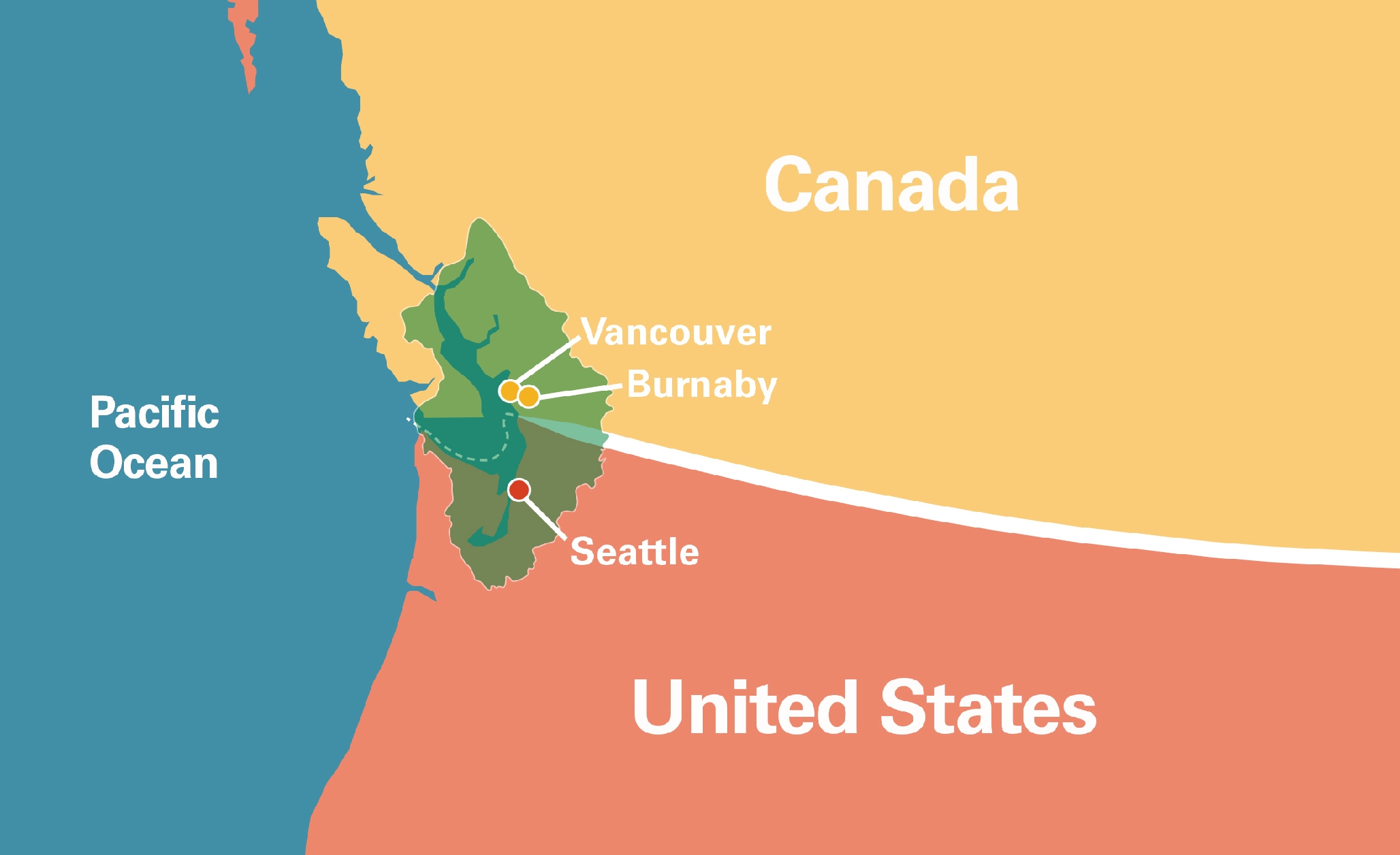
Long before the international border was drawn here, an indigenous people known as the Coast Salish inhabited these lands and waters – 4,500 miles of coastline, ranging from Olympia to Nanaimo, as well as 419 islands strewn throughout the Salish Sea.
It’s estimated that humans have been in the Pacific Northwest since around the time it became inhabitable after the first ice age — about 12,000 years ago. Warming waters were inviting to both a thriving ecosystem and salmon population. Though the first people in the region were likely hunter-gatherers, over time villages were established and eventually the region was home to the Coast Salish, a population living along the shorelines of the Salish Sea throughout Washington State and into British Columbia.
The Salish Sea is also one of the most ecologically diverse regions in North America.
The Coast Salish had a variety of dialects within a Straits Salish language group spanning across the 49th parallel. Despite being organized in different groups and tribes, the Coast Salish were united by the sea and also entwined with it.
The various tribes’ relationships to the seven different species of Pacific salmon – and of the rest of the Sea’s plant and animal life – was of great importance. The groups developed sophisticated fishing methods and practices so as to live sustainably. Subsistence living in a place of abundance wed the Coast Salish peoples to the sea. So conjoined were their fates that Coast Salish named the killer whales “qwe lhol mechen” or “our relations below the waves.”
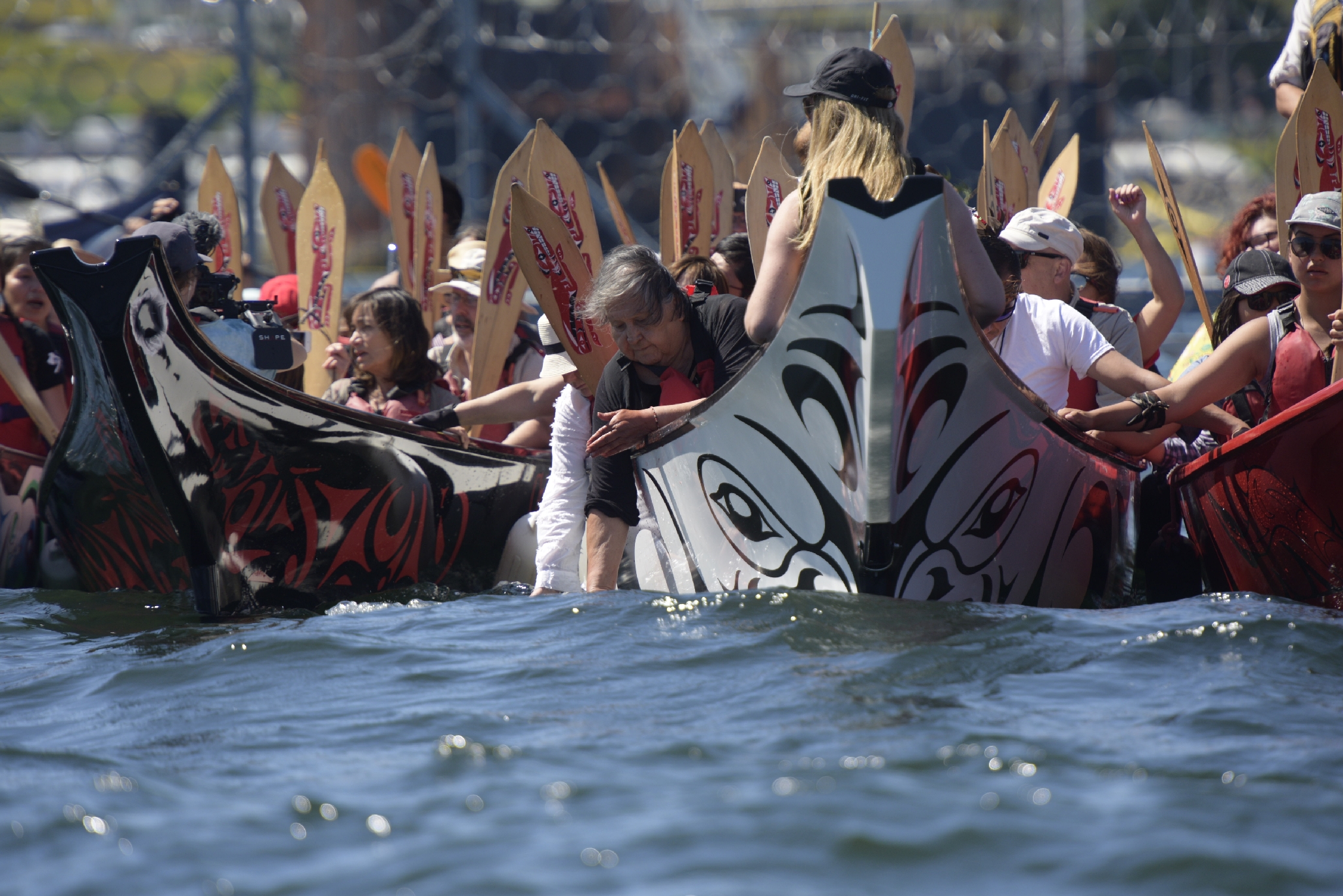
After Captain James Cook set foot on these shores in the late 18th century, those who followed him brought naval, commercial shipping and tourism industries that now to threaten the Salish Sea’s ecological health and balance. Recent developments are alarming. From 2008 to 2011, for instance, the number of species in the Salish Sea that are designated as endangered or threatened almost doubled, from 64 to 113.
The colonizers who followed Cook also brought international borders and reservation boundaries that divided the Coast Salish and displaced them from their ancestral lands. But the Coast Salish are now using their collective voice, organizing across the divide between the U.S. and Canada to protect the sea to oppose new coal centers and pipelines in the region. They are also creating new structures of unitary cooperation across those borders.
Raynell Morris, an elder of the Lummi tribe living in Washington, says transboundary efforts are essential. “We do include our tribes on both sides of the border, because we don't see the border,” Morris told me. “Qwe lhol mechen, orcas, don't see the borders. [Nor do] salmon, [nor] indigenous people.”
Disconnecting a Pipeline
Stewardship is central to the Coast Salish identity. But the international border in the Salish Sea has long deprived indigenous groups playing a central role in its governance.
The series of treaties signed between Great Britain and the United States in the 19th Century to govern the region (and, later, those fashioned by Americans and Canadians) took scant notice of the claims of the Coast Salish.
That lack of power had consequences. In 1856, Washington Territory’s first governor, Isaac Stevens, forced indigenous groups off of more than sixty-four million acres of their terrain. Many of them were relocated to reservations on agricultural land, despite the fact that they had no experience with farming. Meanwhile, white settlers established themselves on rivers, and occupied fisheries once maintained by the Coast Salish.
"Indians holding valuable salmon fishing sites limited who could fish when, and they developed social customs and belief systems around the act of fishing, especially early in the season."
Dr. Kurt Russo, who works in the Sovereignty and Treaty Protection Office of the Lummi Nation, articulates the psychic toll inflicted on the Coast Salish by the border and the reservations. “If you look at the convention of the reservation, it's all about borders. ‘Got to keep these people contained.’ But it's more than that. It is a way of changing a world-making process. When you say, ‘You can't go over there, you've got to stay here,’ that's traumatic. And I would say the continuing assertion of a border, and even a reservation boundary, is a continuing trauma visited on tribes, ongoing and very subliminal.”
Ongoing environmental damage to the Salish Sea is another source of trauma for people whose legacy is its stewardship. Commerce has flooded the region in the 20th and 21st centuries, bringing with it an uptick in military naval activity, as well as increased commercial shipping – including the use of the sea as an ocean passage for fossil fuel tankers. The arrival of burgeoning aerospace and tech industries has made population growth another ecological risk. In 2000, the population of the Seattle metropolitan area was 3 million people and is projected to be nearly 4 million by 2022.
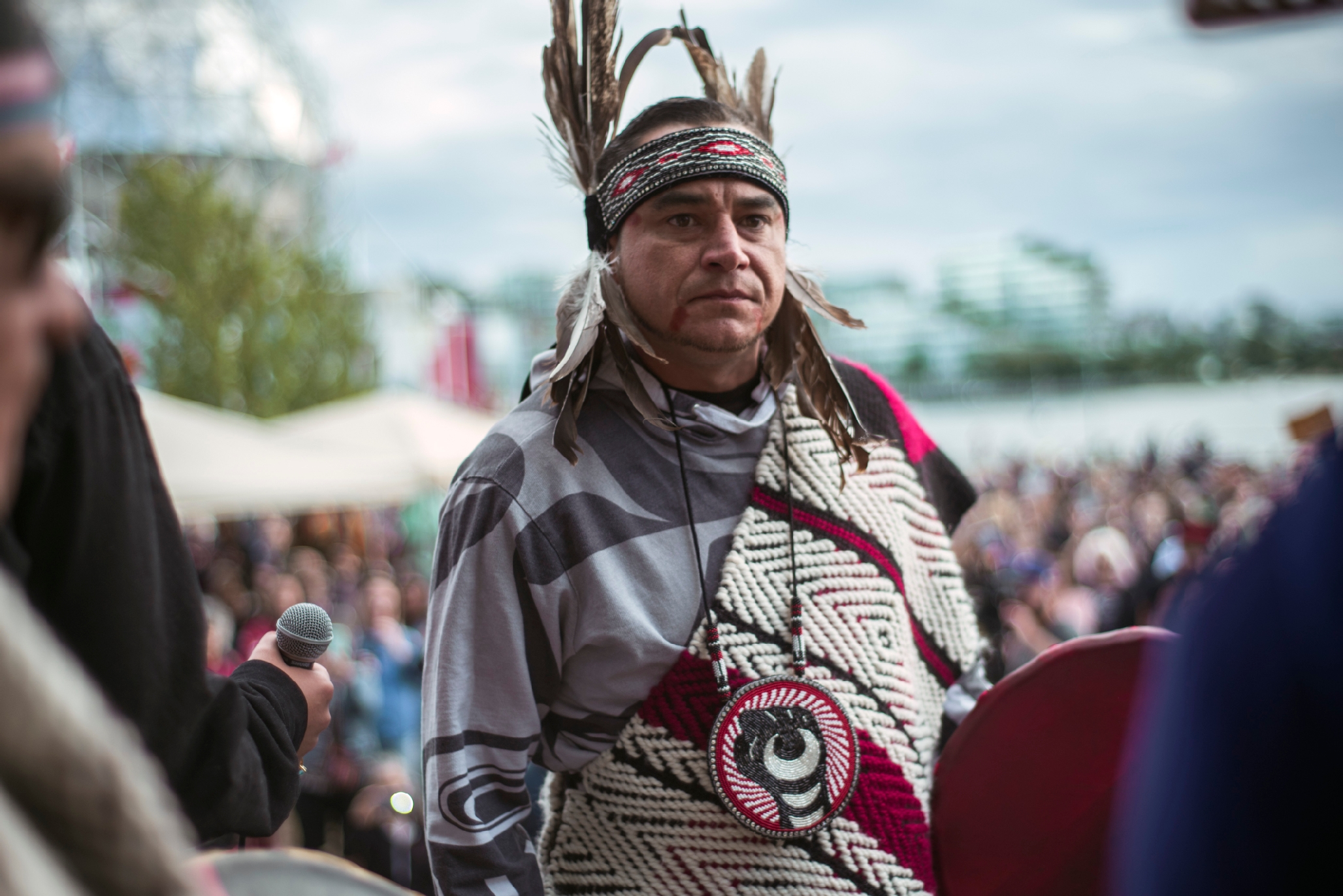
“We go out on the Salish Sea often,” says Morris. “Our fishers do [so] for their treaty right to harvest. Our tribe has had six spiritual ceremonial feedings for qwe lhol mechen where we take live Chinook, and we go out and pray, and offer them to qwe lhol mechen, and, gosh, it is heartbreaking in those journeys out in the waters to see the traffic. To see the cargo ships, to see the oil tankers, to see the tugboats, to see the ferries, you know, and then you add the whale-watching boats, then you add the recreational, and then you add the nontribal fishers. It is a highway on that water.”
Morris and other members of the Lummi, a Coast Salish tribe on the U.S. side of the border, have played a leadership role in ensuring indigenous rights are recognized. Recently, Coast Salish leaders have organized across borders to combat a Canadian pipeline project that will greatly expand fossil fuel shipments in the sea.
Houston-based energy company Kinder Morgan filed its application to create the Trans Mountain Pipeline in late 2013, proposing to expand the usage of an aging pipeline that ran from the tar sands complex in Edmonton, Alberta to the Westridge Marine Terminal in Burnaby, British Columbia, near Vancouver. From there, the fossil fuel (diluted bitumen or dilbit) would make its way to growing energy markets in Asia. Seventy percent of that fuel would leave by tanker from a newly-expanded Westridge terminal, travelling through the long and narrow Burrard Inlet – a waterway off the Salish Sea that leads to both Vancouver and Burnaby.
Burrard Inlet was once one of Canada’s most diverse ecosystems, teeming with wildlife. It was also the ancestral home of the Tsleil-Waututh, a Coast Salish nation, who resided there for thousands of years. Over the course of several generations, commerce has done immense harm to marine life on the inlet, and species foundational to the Tsleil-Waututh’s subsistence economy – rockfish and salmon, shellfish and surf smelt – are now scarce.
As lawyer and writer Merrell-Ann S. Phare explains, “Western water laws and policies have created a separation between indigenous peoples and the rest of society, so indigenous ideas about interconnection, responsibility, and reciprocity have not infiltrated western ways of thinking about water.”
It’s estimated that humans have been in the Pacific Northwest since around the time it became inhabitable after the first ice age — about 12,000 years ago.
The Tsleil-Waututh viewed the pipeline proposal as a new assault to an area sacred to the tribe – and an infringement of its treaty rights. And because 28 kilometers of the project fell within an area requiring consultation with the Tsleil-Waututh, the tribe had the right to carry out an assessment of the possible harm the proposal might cause.
Tanker traffic was a key focus of the Tsleil-Waututh’s assessment. Tanker departures were projected to increase sevenfold – from one ship a week to at least one vessel per day. The increase in traffic from the new terminal worked out to thirty-four tankers a month, and four hundred and eight every year.
The Tsleil-Waututh also observed that potential environment damage would not be limited to Canadian waters. To clear the floor of Burrard Inlet, tankers are only allowed to be seventy percent full. Any overloaded vessel would risk running aground, with the potential for creating oil spills that would affect the entire Salish Sea.
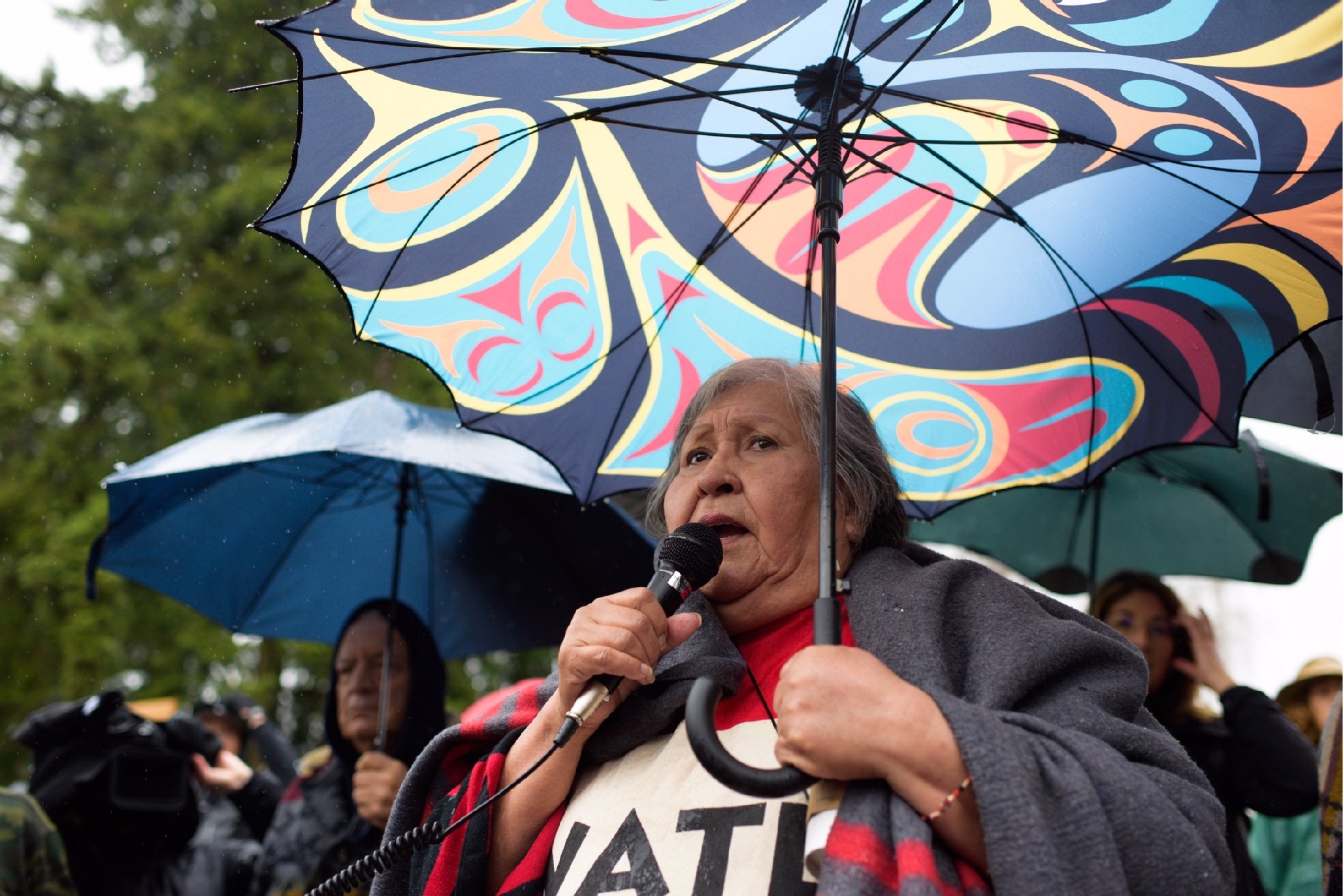
But the Tsleil-Waututh and other Coast Salish groups fighting the pipeline had reason for optimism from previous battles. In May of 2016, the Lummi Nation successfully shut down a plan to build the biggest coal terminal in North America in Cherry Point, Washington.
The Cherry Point plan had strong similarities to the Trans Mountain Pipeline. Up to 450 tankers a year would traverse Lummi fishing waters to reach the proposed coal terminal. After Coast Salish tribes united to fight the plan, the U.S. Army Corps of Engineers determined that the Cherry Point plan was an unavoidable infringement on the Lummi’s treaty rights.
Our tribe has had six spiritual ceremonial feedings for qwe lhol mechen where we take live Chinook, and we go out and pray, and offer them to qwe lhol mechen, and, gosh, it is heartbreaking in those journeys out in the waters to see the traffic.
With the successful termination of Cherry Point, Robert Anderson, the director of the Native American Law Center at the University of Washington School of Law told the Seattle Times, “This is different from an environmental group coming in and saying ‘you shouldn’t do this.’ Here, agencies’ discretion is limited.” The Lummi defense of their rights won in court. “Tribes have treaty rights and the U.S. has trust responsibility to uphold those rights. That is the game-changing possibility here.” This was encouraging for Trans Mountain.
As environmental and indigenous groups exerted pressure on Kinder Morgan, the company backed out of the project. But the Canadian government did not let it die. Government officials proposed to purchase the pipeline and continue the plan, seeing a potential to create thousands of jobs and bring in hundreds of millions of dollars in tax revenue. When Canada’s Prime Minister Justin Trudeau signed off, Canadian government bought the Trans Mountain Pipeline from Kinder Morgan for 3.5 billion dollars in May 2018.

The battle to frame public perception of the merits of indigenous groups’ opposition to the projects has been intense. After the purchase, Trudeau stated “Canada has completed the deepest consultations with rights holders ever on a major project in this country. And working with our indigenous partners has been paramount.”
Indeed, members of some indigenous groups elsewhere in Canada have proposed that they purchase sections of the pipeline and reap its benefits. As Delbert Wapass, former chief of Saskatchewan’s Thunderchild First Nation, told The Washington Post earlier this fall, “If you’re no longer stuck managing poverty, now you’ve moved the needle where you’re starting to manage wealth.”
Trudeau’s reelection as Canadian Prime Minister in late October has increased the odds that the project will continue. But Coast Salish peoples, led by the Lummi and the Tsleil-Waututh, have continued their fight against the pipeline and other new projects in the region, calling for a moratorium on any new development on the Salish Sea pending a comprehensive, transboundary impact assessment.
Transcending Boundaries
Ecology and history are key factors in why Coast Salish tribes are mobilizing their legal, political, and moral weight behind more effective and comprehensive transboundary governance of the Salish Sea.
The 2010 decision to combine the once-geographically distinct Puget Sound and the Georgia Basin as the Salish Sea was an important step. Swinomish Indian Tribal Community Chairman Brian Cladoosby wrote at that time that “the naming of the Salish Sea is a timely response to the need for the governing bodies of the region to recognize their common responsibility for protecting the health of this precious ecosystem.”
Uniting the two regions under one name has helped bring indigenous rights to a more prominent place into conversations about Salish Sea governance. But this one step is perhaps not enough. Though some treaties that allow the Coast Salish to assert influence remain in force, tribal representatives have not been placed into key governance positions.
“We do include our tribes on both sides of the border, because we don't see the border. Qwe lhol mechen, orcas, don't see the borders. [Nor do] salmon, [nor] indigenous people.”
Distinct styles of management at institutions on both sides of the U.S. / Canada border tend to frustrate closer transboundary cooperation. The Environmental Cooperation Council (ECC) – adopted in 1993 – is a transboundary treaty that seeks to improve the United States and Canada’s ability to communicate, share information, and work on coordinated planning. But this agreement has faded into irrelevance in the years after 9/11, as the border between the two nations became more indurate.
Yet as the ECC faded in effectiveness, Northwest Native American groups of the region have taken the initiative to create their own structures of transboundary cooperation. The Coast Salish Gathering is an indigenous-led governing body created in 2005, and it comprised of more than seventy tribes on both sides of the U.S. / Canada border. The Gathering rejects the legacies of colonial borders, international boundaries, and reservations, seeking instead to reframe transboundary governance “to a scale that ‘makes sense ecologically and culturally’ for native people.”
Boundaries are not a foreign concept to the Coast Salish. Historically, they have created boundaries as a means of conservation. The Pacific Salmon, for instance, is a fish that is central to the lives of the Coast Salish and to the health of the entire Salish Sea ecosystem. The salmon population had been successfully managed in areas controlled by the group’s tribes for centuries.
As Lissa K. Wadewitz observed in The Nature of Borders: Salmon, Boundaries and Bandits on the Salish Sea, “Native borders were created to apply property and access rights to certain fishing locations that, in the pre- and early-contact eras, tended to protect the runs from overexploitation. Indians holding valuable salmon fishing sites limited who could fish when, and they developed social customs and belief systems around the act of fishing, especially early in the season.”
Cooperation in preserving the environmental health of the Salish Sea, as well as the creation of the Gathering, have given the Coast Salish a sense of hope that they will successfully navigate borders with greater unity.
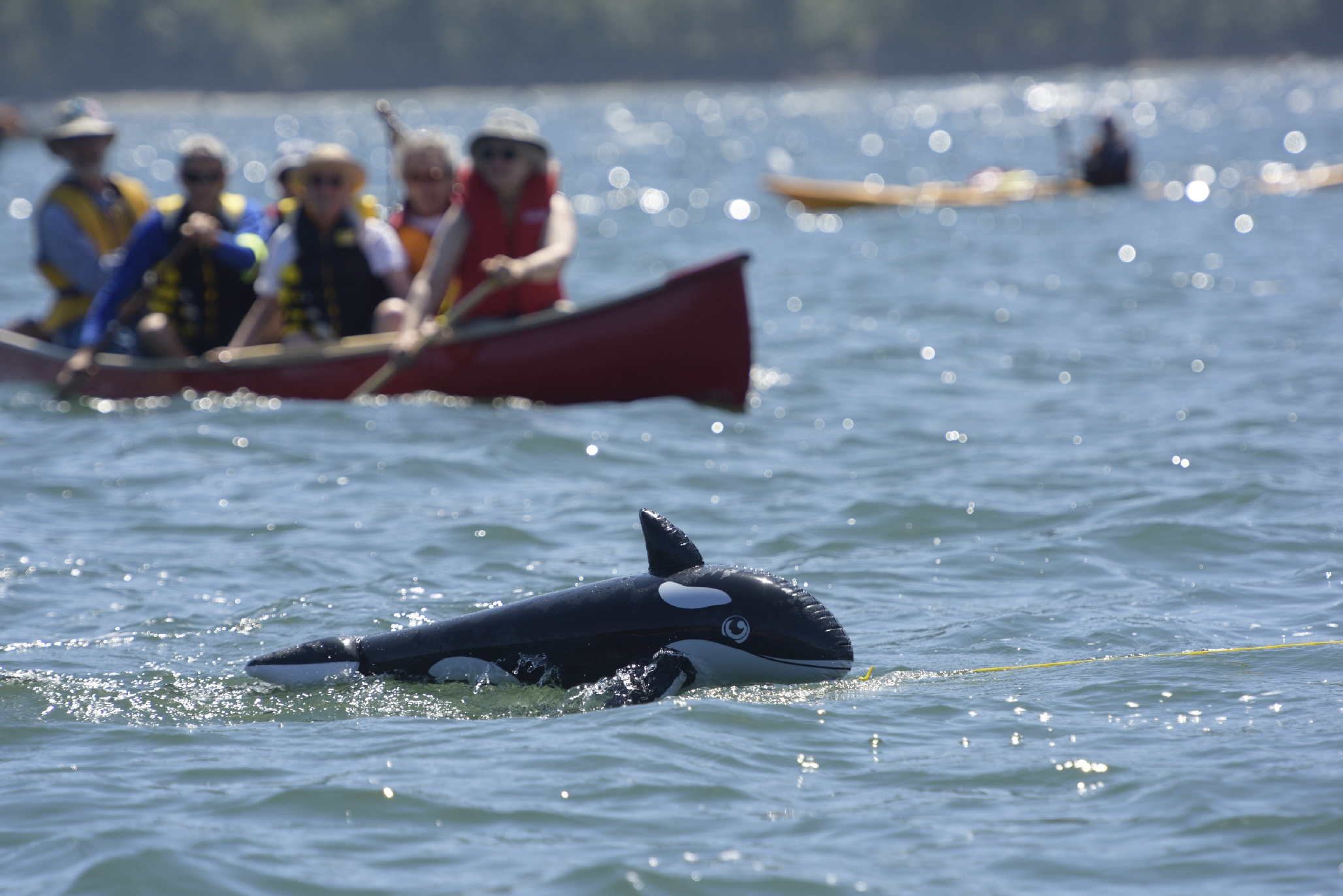
Borders are a human construct, a means of asserting over control of a space, a situation or group of individuals. They are inherently antithetical to nature where wind, water, fish and mammals are elements of the wild, roaming borderless. This is why the mission of the Coast Salish Gathering is both urgent and hopeful. Pollution is not contained by a border, but neither are the efforts of the Coast Salish to protect the salmon, the killer whales, and other life in the Salish Sea.
Morris made this connection explicit as she spoke of a mandate communicated by Lummi ancestors to today’s generation during a recent burning ceremony. It took place on Henry Island in the San Juans and the group participating were joined by countless ancestors by Morris’ assessment. “What the message came out to us was that it's our obligation, our sacred obligation, to heal the Salish Sea,” she told me.
“They told us if we heal the Salish Sea,” Morris recalled, “heal the salmon, heal qwe lhol mechen – the orcas – [it will] heal us, and that there is hope. It's hard work, but there is hope.”
Kea Krause is a writer originally from the Pacific Northwest now based in New York.
Cover: A killer whale – or “qwe lhol mechen” in Coast Salish – breaches in view of Mount Baker in the Salish Sea in the San Juan Islands, Washington in July 2015. (AP Photo/Elaine Thompson)
.jpg&w=3840&q=75)